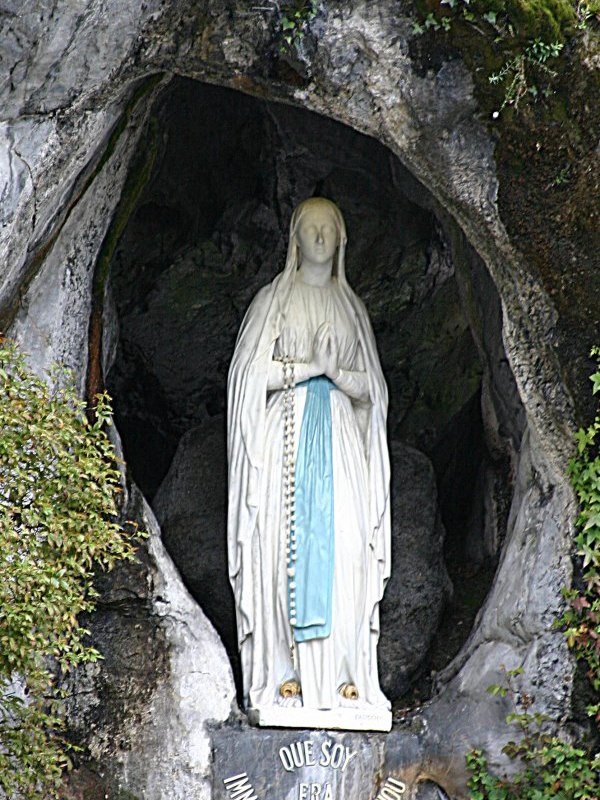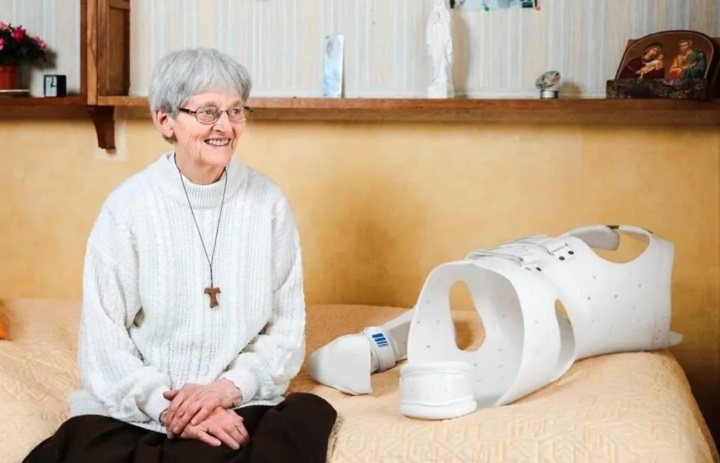
What happened in Lourdes - an overview
In addition to the personal testimonies on this website, the events in Lourdes are summarised here in an overview.
On 11 February 1858, Mary, the Mother of Jesus, appeared to the 14-year-old girl Bernadette Soubirous in a small grotto near Lourdes, at a time when revolutions and the Enlightenment were stirring up opposition to the Church.
During one of these apparitions, a previously non-existent spring began to flow in this grotto called Massabielle. Soon the first spontaneous healings took place at this spring, which could not be explained medically. As a result, Lourdes developed into a place of pilgrimage to which many people with serious illnesses and ailments made pilgrimages in the hope of experiencing the gift of healing.
As sceptics repeatedly accused the place of being merely a staging ground for the Church, a medical commission was set up to investigate these healings. In this international association (A.M.I.L. - Association Medicale internationale de Notre Dame de Lourdes), it is expressly desired that the doctors and scientists working there do not belong to any religious community, so as not to be able to offer a starting point for criticism due to a lack of objectivity[1].
In the meantime, over 7,400 healings have already been reported to the A.M.I.L. and verified by them[2]. Around 2,500 healings have been categorised as "extramedical". This means that they cannot be explained scientifically in any way. Such healings must be medically documented beyond doubt, occur spontaneously (i.e. not represent a prolonged healing or regression process) and be complete and permanent. This includes, for example, bone fractures that healed instantly, complete and immediate healing of multiple sclerosis, irreversible paralysis or malignant tumours that suddenly regressed completely. Of these inexplicable healings, 70 were labelled as "miracles" by the church after lengthy and complex examination procedures[3],[4].
This small number of miracles recognised by the Church can be easily explained: When people travel to Lourdes to ask God for healing through the intercession of Mary, they do not do so in order to serve as evidence and visualisation in the event of an actual healing. If they experience the grace of healing, they must be prepared to undergo extensive investigations and multi-stage examination processes at the A.M.I.L., which often extend over many years, in order for this to be officially registered at all. They must also be prepared to expose themselves publicly. Complete medical records must be presented, from which the fact of a medically inexplicable cure can be unequivocally demonstrated. These are conditions that many people are not willing or even able to fulfil. For example, anyone who has booked a trip to Lourdes as a seriously ill person and has been cured would have to cancel the return trip / return flight for themselves and the person accompanying them, book and finance an extended stay in Lourdes for the necessary examinations, and also have the willingness, time and financial resources to travel to Lourdes again and again in subsequent years so that relapses can be ruled out in further examinations. In addition, those who come from countries that do not have Western European medical standards will not always have such high-quality and, above all, complete medical findings, including results from MRI and CT examinations, that the A.M.I.L. can rule out with absolute certainty any normally explainable healing or any, even subliminal, medical assistance in the healing process. This examination process is intensified if the Church is also to recognise these healings as miracles.
The Church must be careful when it comes to recognising miracles, because its credibility is at stake. For example, a spontaneous healing of a terminal tuberculous peritonitis confirmed by a Nobel Prize winner in medicine, Prof. Alexis Carell, was not recognised as a miracle by the Church. This was despite the fact that Carell had examined the woman concerned (Marie Bailly) on the day of the healing and had assumed that she would not survive that day; he stood next to her during the healing and was a direct witness to this event. He then examined the suddenly healthy woman together with other doctors. There could not be the slightest doubt about her scientifically inexplicable healing. A few years later, however, this healing was not recognised as a miracle because not all theoretically conceivable other diseases of the abdomen had been examined and excluded during the examinations[5].
It is therefore understandable that in addition to the 7,400 reported healings, there are also a large number of unreported healings, because only very few people actually have the opportunity and willingness to undergo this marathon examination.
[1] https://www.amilourdes.com/
[2] Archiv von Lourdes: http://web.archive.org/web/20160314081810/http://de.lourdes-france.org/vertiefen/heilungen-und-wunder/die-geheilten-von-lourdes
[3] https://www.vaticannews.va/fr/eglise/news/2019-01/bernadette-moriau-miracle-lourdes-temoignage.html
[4] Resch Andreas, Institut für Grenzgebiete der Wissenschaft, Innsbruck, https://www.imagomundi.biz/wunder-von-lourdes/
[5] Jaki Stanley: Two Lourdes Miracles and a Nobel Laureate: What Really Happened? in: https://epublications.marquette.edu/cgi/viewcontent.cgi?article=2206&context=lnq
Foto: https://www.lepelerin.com/religions-et-spiritualites/les-grandes-figures-de-leglise/soeur-bernadette-moriau-70e-miraculee-de-lourdes-4606
The last healing recognised as a miracle concerns Mrs Bernadette Moriau. After her spontaneous healing in 2008, there were three complete examination cycles up to 2016, in which a large number of new scientists were involved. Her mental state, as well as all the facts and healing hypotheses, were re-examined from scratch each time and additional examinations were organised. In the end, well over 200 doctors and psychologists took part in the investigations, which ultimately confirmed that in her case, too, it was a scientifically inexplicable spontaneous healing of her paralysis, which had existed for many years, due to irreversible anatomical and neurological damage. It is worth remembering the amount of investigation Mrs Moriau voluntarily underwent before this medically and scientifically inexplicable healing was recognised by the Church as a miracle.
The decisive factor, however, is that the events in Lourdes were not triggered by any healing spring water, but happened exclusively in a religious context and had an important background. It is not the healings that should be at the centre of the events, but the fact of Mary's apparitions. In a time of revolutions and "enlightenment", she called on people to turn to God again, contrary to the spirit of the times, and also urgently emphasised the necessity of prayer. In particular, prayers should be said on behalf of those people who do not yet know God, so that they too can repent. Accepting and responding to God's love would also be much more important than a knowledge of faith without consequences.
For our encounter with God, it will one day not be decisive whether we are physically unharmed and can look back on a successful life, but whether we are whole in soul. We will be if we centre our lives on the message of Jesus. The fact that Mary is not only allowed to appear to people in Lourdes and repeatedly gives clear indications of the path of faith to be followed, enlightens our understand that God has enabled Mary to give us humans the appropriate help. The repeatedly recognisable miracles are signs of the authority she received from God. After all, as the mother of Jesus, she knows best what he described as important for our lives before God.
